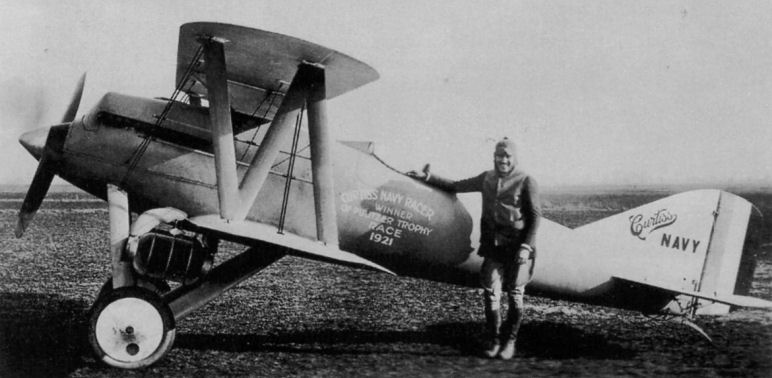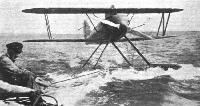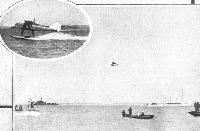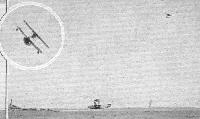
Варианты
- Curtiss - CR / R-6 - 1921 - США
- Curtiss - PW-8 - 1923 - США
Curtiss Model 23 (CR и R-6)
Кертис приступил к проектированию и постройке гоночных самолетов в начале 1920 года, отправной точкой стал заказ миллионера С.Кокса на разработку и постройку двух самолетов, которые должны были принять участие в гонках на Кубок Джеймса Гордона Беннетта, проводившихся в сентябре того же года во Франции. Разработанный Кертисом самолет получил обозначение Curtiss Сох Racer (затем - Model 22), а самим машинам были присвоены собственные названия - "Texas Wildcat" и "Cactus Kitten". Они представляли собой подкосные высокопланы, оснащенные одним V-образным двигателем Curtiss C-12 мощностью 427 л.с. До отправки во Францию испытания прошел только "Texas Wildcat", по прибытии он прошел дополнительные испытания, в ходе которых выявились недостатки, связанные со слишком тонким крылом. Проектная группа Кертиса быстро спроектировала нижнее крыло, которое поставили на машину, но при перегонке самолета к месту старта было повреждено шасси, и при посадке самолет получил сильные повреждения, не позволившие ему принять участие в соревнованиях. Второй самолет, "Cactus Kitten", так и не поднялся в воздух и был возвращен в США, где на него установили трипланную коробку с крыльями малого размаха, и в таком виде самолет занял второе место в гонках на Кубок Пулитцера в 1921 году.
Победителем той гонки стал другой самолет конструкции Кертиса - один из принадлежавших компании бипланов типа Model 23, построенных для ВМС США под обозначениями CR-1 (временное обозначение L-17-1) и CR-2. ВМС США сами намеревались принять участие в соревновании, но затем отказались от этой затеи, поэтому Кертис арендовал у флота CR-2. И CR-1, и CR-2 представляли собой бипланы с неубирающимся шасси с хвостовым костылем и оснащались V-образным двигателем Curtiss CD-12, но имели и ряд незначительных отличий. Вскоре они были переоборудованы под гидросамолеты CR-3 (Model 23А, временное обозначение L-17-3) для участия в гонках на Кубок Шнейдера, проводившихся в 1928 году в Великобритании. Среди прочего на самолеты установили новые двигатели Curtiss D-12 мощностью 465 л.с. с металлическими воздушными винтами Curtiss-Reed. В итоге самолеты заняли сразу первое и второе места.
Принимая во внимание набиравшее в то время соперничество между американскими Армией и Военно-морскими силами, не вызывает удивления тот факт, что армейское командование тут же решило приобрести два самолета типа R-6 - дальнейшего развития флотских CR. Новая машина имела более чистые аэродинамические формы, что позволило армейским летчикам взять первые два места в гонках на Кубок Пулитцера в 1922 году и дважды устанавливать мировой рекорд скорости (второй раз - 380,74 км/час).
ТАКТИКО-ТЕХНИЧЕСКИЕ ХАРАКТЕРИСТИКИ
Curtiss Model 23 (R-6)
Тип: одноместный гоночный самолет
Силовая установка: один V-образный ПД Curtiss D-12 Special мощностью 460 л.с. (343 кВт)
Летные характеристики: максимальная скорость на оптимальной высоте 381 км/час; дальность 455 км
Масса: пустого 733 кг; максимальная взлетная 962 кг
Размеры: размах крыла 5,79 м; длина 5,75 м; высота 2,31 м; площадь крыльев 12,63 м2
Описание:
- Curtiss Model 23 (CR и R-6)
- Flight, October 1922
THE 1922 PULITZER TROPHY RACE
Фотографии
-
Мировая Авиация 96
Лейтенант Лестер Дж. Мэйтланд из авиакорпуса Армии США занял на этом R-6 второе место в гонках на Кубок Пулитцера в 1922 году.
-
Мировая Авиация 73
Обладатель Кубка Пулитцера. 5 ноября 1921г.: после отказа ВМС США от участия в гонках на приз Пулитцера фирма "Curtiss" взяла в аренду самолет CR-2, который должен был принять участие в гонках от ВМС. CR-2 пилотировал летчик-испытатель фирмы "Curtiss" Берт Акоста. Так как Армия США тоже отказалась от участия в гонках, то единственным достойным конкурентом Акосты остался триплан Curtiss-Cox. Акоста на CR-2 с гоночным номером "4" показал скорость 284,36 км/ч, установив тем самым новый рекорд скорости при полете по замкнутому маршруту.
-
Flight 1921-12 / Flight
The winner of the Pulitzer Race: The Curtiss-Navy Racer flown by Bert Acosta.
-
Flight 1922-10 / Flight
Регистрационный номер: A-6081 THE PULITZER TROPHY RACE: The Navy-Curtiss Racer entered by the U.S. Navy. This machine has radiators embodied in the wings (the previous Navy-Curtiss Racer having Lamblin radiators), 400 h.p, Curtiss CD 12 engine.
-
Flight 1923-03 / Flight
WING RADIATORS: One of successful types of wing radiators - the Curtiss
-
Flight 1922-10 / Flight
THE PULITZER TROPHY RACE :- One of the two Army-Curtiss Racers entered by the U.S. Army Air Service. These machines have wing radiators, and are fitted with 375 h.p. Curtiss D 12 engines. One of these machines, piloted by Lieut. R. L. Maugham, won the trophy at a speed of 206 m.p.h.
-
Мировая Авиация 43
13 октября 1922г.: Первый полет гоночного Curtiss R-6, который строился для участия в гонках на Кубок Пулитцера, а в 1923 году установил мировой рекорд скорости (380,67 км/ч).
-
Flight 1923-08 / Flight
One of the Schneider Cup challengers under test: The American Curtiss-Navy Racer, type C.R.3, with 400 h.p. Curtiss D.12 engine, on which Lieut. Irvine established, on June 30, what is claimed to be a world's record for seaplanes by averaging, over a 4.26 miles course, 175.3 m.p.h.
-
Flight 1923-09 / Flight
Towing her out for a test: The Navy-Curtiss, photographed off Cowes. Note the clean design.
-
Flight 1925-11 / Flight
THE 1923 SCHNEIDER CUP WINNER: The Navy-Curtiss racer, 500 h.p. Curtiss D.12 engine.
-
Air Enthusiast 1972-02 / In print
The illustration taken during the 1923 Contest for the Schneider Trophy - the second time the event had been held in Britain, and the first to be won by the USA. Shown is the winning Curtiss CR-3, racing number 4, in which Lt David Rittenhouse, USN, achieved a speed of 177.38 mph (285,5 km/h).
-
Flight 1923-10 / Flight
THE NAVIGABILITY TESTS: The two American representatives taxi-ing across the line.
-
Flight 1923-10 / Flight
WINNING THE SCHNEIDER TROPHY: This photograph shows the scene at the finish, with Lieut. David Rittenhouse. on the Navy-Curtiss racer, crossing the line after having covered the course at an average speed of 177.38 m.p.h. Mr. Withers' steam yacht, with a black cone hoisted, was one of the mark boats, and is seen on the right. On the left is a representative of the British Navy, a "P" boat, while in front is an American launch with the crew cheering the winner . The inset shows Rittenhouse starting in the race, and just by the nose of his machine may be seen the front portion and floats of the other American competitor, No.3, who got off a second or so before No.4.
-
Flight 1923-10 / Flight
Lieut. Irvine (in shirt sleeves in middle of boat) going ashore after securing second place in Schneider Cup.
-
Flight 1923-10 / Flight
The Schneider Cup Race Winners: On the right, Lieut. Rittenhouse being congratulated by his friend and compatriot Lieut. Irvine, who was second. The insets show the two Curtiss-Navy machines used. Irvine's cornering was, if anything, better than Rittenhouse's, but No. 3 was the slower machine.
-
Flight 1923-10 / Flight
THREE OF THE COMPETITORS ON SAUNDERS' SLIPWAY ON THE MORNING OF THE RACE: On the left, the Curtiss-Navy No. 3. In the centre, the Supermarine, and on the right, the C.A.M.S. 38
Другие самолёты на фотографии: CAMS CAMS 36 / CAMS 38 - Франция - 1922Supermarine Sea Lion / Sea King - Великобритания - 1919
-
Flight 1923-10 / Flight
THE MOORING TEST: The six machines in line are, left to right, the Supermarine "SeaLion III," the two American Navy-Curtiss seaplanes, the C.A.M.S. flying boats, and the Latham twin-engined flying boat.
Другие самолёты на фотографии: CAMS CAMS 36 / CAMS 38 - Франция - 1922Latham L-1 / L-2 - Франция - 1923Supermarine Sea Lion / Sea King - Великобритания - 1919
-
Flight 1923-10 / Flight
THE SCHNEIDER CUP RACE: Capt. Biard, on the Supermarine "Sea Lion III," gets away, just as the American Navy-Curtiss No. 4 (Rittenhouse) rounds the mark boats after finishing his first lap. Inset shows Capt. Biard turning.
Другие самолёты на фотографии: Supermarine Sea Lion / Sea King - Великобритания - 1919
- Фотографии


















